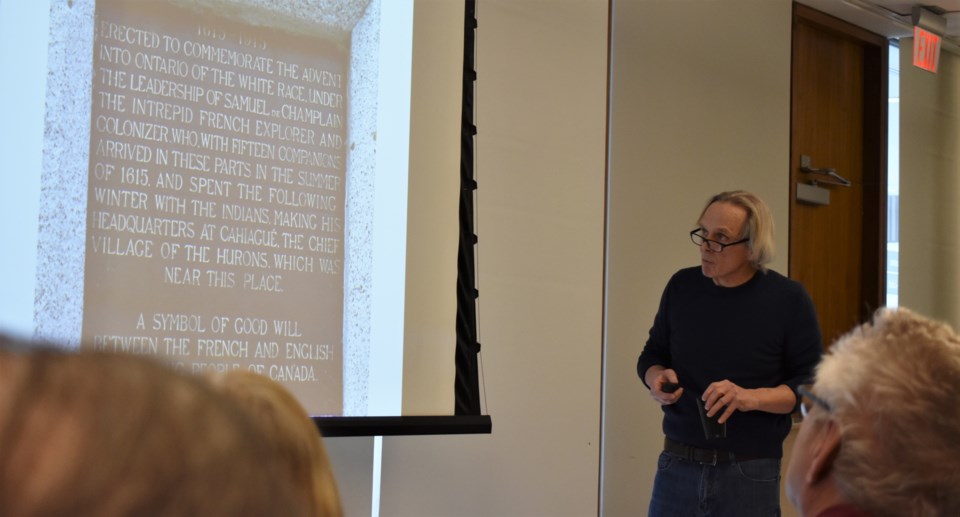In recent weeks, controversy has swirled in Ottawa around the National Holocaust Memorial, which was erected just a year ago. As a result of mounting pressure about wording on the memorial’s main plaque, a new plaque will be unveiled this spring.
But in Orillia, a similar scenario has been met mostly with silence, says Kim Fedderson, the former principal of Orillia’s Lakehead University campus. Like many, he found himself drawn to the waterfront this summer when Parks Canada began removing the iconic Champlain Monument from Couchiching Beach Park, where it has stood since its celebrated unveiling in 1925.
Parks Canada has removed the bronze statues and the plinth for restoration; it is to be put back in its place this summer. The project spurred talk about potentially supplementing the monument – and its narrative – with a separate installation to help provide a more modern context to the work of art.
“There was some talk about a new project to be added, there were some stories in the newspapers, but on the whole, things have been quite quiet,” said Fedderson. “That quiet bothered me because we have this very controversial monument in the centre of our city and (we’re) not talking about it as much as we should be. Decisions are being made and actions are being taken with, as far as I know, not a lot of consultation. That is why I wanted to open up a conversation.”
That conversation – Champlain Monument’s place in the unfolding culture of Orillia – was held Tuesday afternoon at the Orillia Public Library. More than 75 people jammed into the meeting room for the standing-room-only event.
Fedderson, aided by slides, presented a detailed history of the four statues commemorating Champlain in Canada, with a focus on Orillia’s bronze memorial created by Vernon March. While conceding that, “aesthetically, it’s a triumph,” Fedderson detailed the monument’s shortcomings.
“Like the Twin Towers in New York, the Orillia Champlain Monument materializes – by that I mean casts in stone in bronze – a narrative, not an authentic or accurate historic picture,” said Fedderson. “It’s an imagined depiction… a distorted lens through which the past is to be remembered.”
He said the narrative is “founded on the romantic origin in which a courageous European adventurer and explorer discovers a new world, pacifies its Indigenous population by bringing them the twin gifts of civilization – Christianity and commerce – and begins to navigate the path of progress,” he said. He added the controversial depiction of “Indigenous men as docile, passive, subordinating, subjecting, possessing an eroticized physicality” is another issue many have with the statue – concerns that have been around almost as long as the statue.
“These issues have always been with us, but in the wake of the truth and reconciliation movement, they have a particular salience right now,” said Fedderson, who noted that other countries, when faced with similar issues, have taken different approaches. He noted, for example, statues of Saddam Hussein were demolished when he was toppled from power, while statues of Cecil Rhodes, associated with the colonization of South Africa, were relocated to a museum to provide context. In Ottawa, the native scout was removed from that city’s Champlain monument and relocated to another spot across the river.
Tuesday’s conversation was meant to ignite a debate about what to do in Orillia. It did just that; it also triggered a range of emotions – and an array of potential ideas. Jacob Kearey-Moreland, for example, suggested the statue should be dumped in Lake Couchiching, so that more important issues, such as ensuring clean drinking water on reserves, could be addressed.
Rama’s Mark Douglas got the crowd’s attention when he asked a pointed question. “Is anyone here from the federal government?” he asked to silence. He noted Rama officials had been working with Parks Canada for 20 years on augmenting his community’s fish fence – a national historic site. “But five years ago, they walked away and never came back.”
While Douglas lauded the conversation and ideas, he wondered aloud about what it might accomplish. “It’s their statue and we don’t have the authority to force them to come and listen to us,” he said, noting their “ignorance” was disheartening.
Fedderson agreed. “It’s interesting what has happened in Ottawa with the Holocaust Memorial. The federal government has talked about the need for consultation – there’s been all kinds of talk,” he said. “Here we have this very controversial monument and there hasn’t been any discussion that I’m aware of. It would be interesting to pursue.”
History buff Jayne Turvey said she didn’t think the permanent removal of the statue was a good idea. “If you erase it, you don’t learn from it,” she said. “I’m not sure what the solution is, but to take it away would be heartbreaking for some and won’t fix anything. Maybe something should be added around it.”
That would make sense, said Valerie Powell, a long-time Green Party candidate. She noted public art, while often controversial, is valuable. “The fact we’ve got some public art, even though they got it all wrong according to modern perspective, is good. If you added more public art to correct or to add to the history… maybe art created by Chippewas, Ojibway… maybe we should lobby the federal government to do that?”
Fedderson hopes Tuesday’s “conversation” continues. “I think it’s a productive time to have a conversation before (the statue) returns. This is a national conversation. It’s connected to some of the most important issues facing Canada as a nation right now and I think we have a role to play.”



